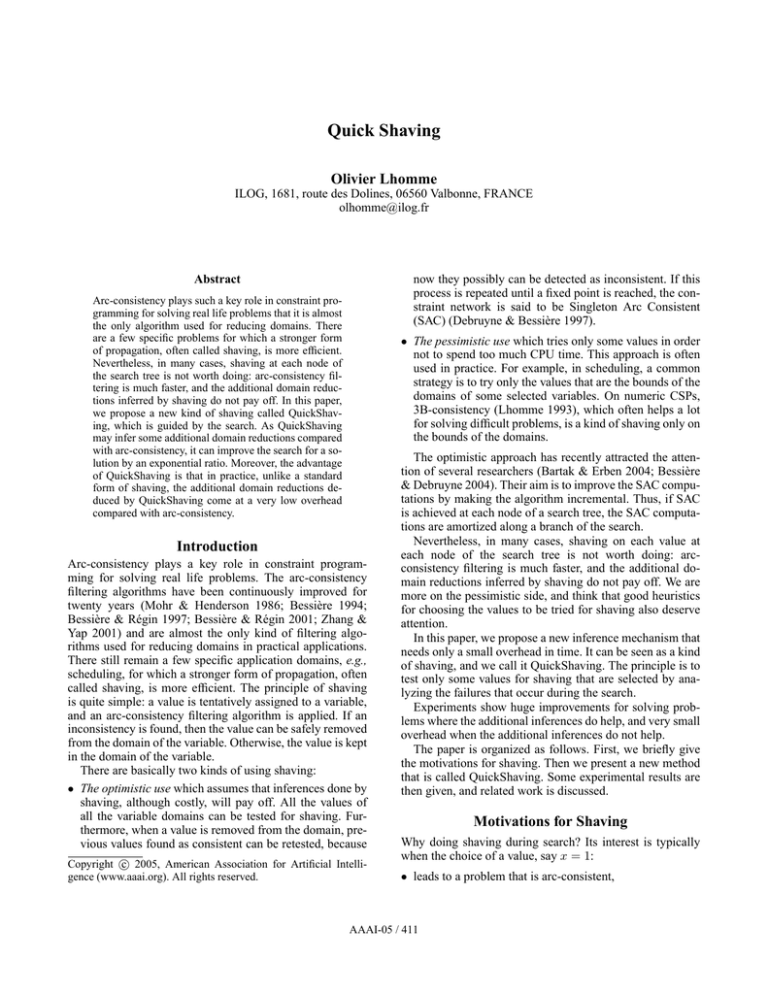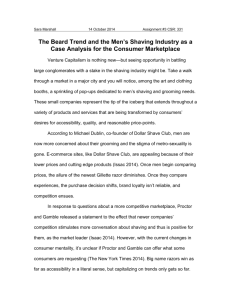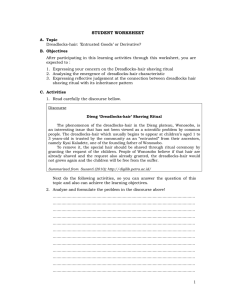
Quick Shaving
Olivier Lhomme
ILOG, 1681, route des Dolines, 06560 Valbonne, FRANCE
olhomme@ilog.fr
Abstract
now they possibly can be detected as inconsistent. If this
process is repeated until a fixed point is reached, the constraint network is said to be Singleton Arc Consistent
(SAC) (Debruyne & Bessière 1997).
Arc-consistency plays such a key role in constraint programming for solving real life problems that it is almost
the only algorithm used for reducing domains. There
are a few specific problems for which a stronger form
of propagation, often called shaving, is more efficient.
Nevertheless, in many cases, shaving at each node of
the search tree is not worth doing: arc-consistency filtering is much faster, and the additional domain reductions inferred by shaving do not pay off. In this paper,
we propose a new kind of shaving called QuickShaving, which is guided by the search. As QuickShaving
may infer some additional domain reductions compared
with arc-consistency, it can improve the search for a solution by an exponential ratio. Moreover, the advantage
of QuickShaving is that in practice, unlike a standard
form of shaving, the additional domain reductions deduced by QuickShaving come at a very low overhead
compared with arc-consistency.
• The pessimistic use which tries only some values in order
not to spend too much CPU time. This approach is often
used in practice. For example, in scheduling, a common
strategy is to try only the values that are the bounds of the
domains of some selected variables. On numeric CSPs,
3B-consistency (Lhomme 1993), which often helps a lot
for solving difficult problems, is a kind of shaving only on
the bounds of the domains.
Introduction
Arc-consistency plays a key role in constraint programming for solving real life problems. The arc-consistency
filtering algorithms have been continuously improved for
twenty years (Mohr & Henderson 1986; Bessière 1994;
Bessière & Régin 1997; Bessière & Régin 2001; Zhang &
Yap 2001) and are almost the only kind of filtering algorithms used for reducing domains in practical applications.
There still remain a few specific application domains, e.g.,
scheduling, for which a stronger form of propagation, often
called shaving, is more efficient. The principle of shaving
is quite simple: a value is tentatively assigned to a variable,
and an arc-consistency filtering algorithm is applied. If an
inconsistency is found, then the value can be safely removed
from the domain of the variable. Otherwise, the value is kept
in the domain of the variable.
There are basically two kinds of using shaving:
• The optimistic use which assumes that inferences done by
shaving, although costly, will pay off. All the values of
all the variable domains can be tested for shaving. Furthermore, when a value is removed from the domain, previous values found as consistent can be retested, because
c 2005, American Association for Artificial IntelliCopyright gence (www.aaai.org). All rights reserved.
The optimistic approach has recently attracted the attention of several researchers (Bartak & Erben 2004; Bessière
& Debruyne 2004). Their aim is to improve the SAC computations by making the algorithm incremental. Thus, if SAC
is achieved at each node of a search tree, the SAC computations are amortized along a branch of the search.
Nevertheless, in many cases, shaving on each value at
each node of the search tree is not worth doing: arcconsistency filtering is much faster, and the additional domain reductions inferred by shaving do not pay off. We are
more on the pessimistic side, and think that good heuristics
for choosing the values to be tried for shaving also deserve
attention.
In this paper, we propose a new inference mechanism that
needs only a small overhead in time. It can be seen as a kind
of shaving, and we call it QuickShaving. The principle is to
test only some values for shaving that are selected by analyzing the failures that occur during the search.
Experiments show huge improvements for solving problems where the additional inferences do help, and very small
overhead when the additional inferences do not help.
The paper is organized as follows. First, we briefly give
the motivations for shaving. Then we present a new method
that is called QuickShaving. Some experimental results are
then given, and related work is discussed.
Motivations for Shaving
Why doing shaving during search? Its interest is typically
when the choice of a value, say x = 1:
• leads to a problem that is arc-consistent,
AAAI-05 / 411
• but there is one variable, say y, deeper in the search tree,
which cannot be assigned without leading to a problem
being arc-inconsistent.
When the variable y is assigned, inconsistency is detected,
but all parts of the tree between x and y must be fully explored before undoing the culprit assignment x = 1. If shaving is applied on y just after the assignment x = 1, the inconsistency can be detected immediately.
Consider the following example. Let x1 , . . . , xn be n variables of a constraint problem. Let us consider a subproblem SP on variables x1 , x10 , x11 , x12 , with associated domains d(x1 ) = {1, 2, 3, 4}, d(x10 ) = {1, 2, 3}, d(x11 ) =
{1, 2, 3}, d(x12 ) = {1, 2, 3}, and with difference constraints
between each pair of variables in SP: x1 6= x10 , x1 6=
x11 , x1 6= x12 , x10 6= x11 , x10 6= x12 , x11 6= x12 .
Consider a backtracking algorithm that performs arcconsistency at each node and that uses static ordering of variables from x1 to xn , and a value ordering that takes first the
smallest value in the current domain.
As soon as x1 is assigned with value 1, 2 or 3, the subproblem is a pigeon hole problem1 : it has no solution but
arc-consistency is not able to see the inconsistency.
The search thus continues by assigning x2 , x3 , . . . , x9 .
When assigning x10 , arc-consistency detects inconsistency.
The search now needs to explore the whole subtree between
x2 and x9 before backtracking to x1 .
If shaving on x10 is applied after x1 is assigned with value
1, 2 or 3, inconsistency is detected immediately and thus the
useless exploration of the whole subtree between x2 and x9
is avoided.
Quick Shaving
The main drawback of shaving is CPU time consumption.
It tries to shave a lot of values in a blind way. This requires
many computations, which are often useless:
• It is clearly a waste of CPU time when testing a value for
shaving leads to an arc-consistent problem: the value still
remains in the domain of the variable but the CPU time is
spent.
• Even when the shaving succeeds in removing a value, the
computations can be useless. For example, it is not efficient to waste CPU time to reduce the domain of x if we
branch on x just after. (Of course the choice of the variable
to branch may depend on the size of the domain and thus
we may argue that sometimes a better informed heuristic
may save exponential time but this is a side effect, and
we will try to separate in our study the inferences and the
heuristics.)
The time spent in all those useless shaving computations
is in general much more than the time spent in useful shaving
1
A pigeon hole problem is a problem where one must find a hole
for each pigeon, such that each pigeon has its own hole, but there
are n pigeons and n − 1 holes. Such pigeon hole problems led to
the introduction of the allDifferent constraint that solves this kind
of problem in polynomial time by using a matching algorithm. But
that is not the point here; we take this example only for illustration
purposes and consider that we do not have allDifferent constraint.
computations. We will see that we can avoid most of them.
First of all, we need to define the term “shavable”:
Definition 1 A value a of a variable x is said to be shavable
when AC is able to detect inconsistency on the problem P 0 =
P ∪ {x = a}.
More generally, a decision or a constraint c is said to
be shavable when AC is able to detect inconsistency on the
problem P 0 = P ∪ c
A perfect shaving algorithm would test for shaving the
shavable values only. Unfortunately, it is not possible to
know in advance which values are shavable. The strategy
we adopt for using shaving in the search is the following: at
depth k, test for shaving only the values that would be shavable at depth k+1. We need to have an oracle that predicts
at depth k what will happen at depth k+1. Backtracking can
be used as such an oracle; its advantage is that it does not
cost additional CPU time. All we need is to keep which values are shavable at depth k+1. Then, when a backtrack to
depth k occurs, we can test for shaving those values that are
shavable at depth k+1.
Thus, shaving is tried only at backtrack, and only on values that are shavable in the next deeper node of the search
tree. But where does the first shavable value come from?
The answer is very simple. It comes from branching, when
assigning a value leads to a direct failure. For example, let
us assume the search is at depth k. The search algorithm
branches on x = 2, and immediately fails. Thus, we know
that x = 2 is a shavable value at depth k, without having
to test x = 2 for shaving. When a backtrack at depth k − 1
will occur, the shavable values at depth k, like x = 2, will
be tested for shaving.
Description of the algorithm
Figure 1 shows an example of how to implement a search
algorithm with the QuickShaving principle. Procedure QSSearch receives as input parameters the constraint problem
P and a constraint to add to P which is a branching decision. Procedure QS-Search also has an output parameter,
shavableList which is a list of values that are shavable after
adding the decision ct to P . Procedure QS-Search returns
true or false, to indicate that a solution has been found or
that there is no solution to the problem P ∪ ct.
The first call to QS-Search gives a constraint that is always true for parameter ct.
If the decision ct leads to a failure, then we know that this
decision is shavable. So, shavableList is initialized to the set
containing this decision.
If there are no more variables to assign, the search is finished and a solution is found. Otherwise, a branching decision is chosen, for example an assignment of a value to a
variable, and a recursive call to QS-search is done.
If the recursive call succeeds, a solution has been found.
Otherwise, we must try the negation of the decision. For example, if the decision is an assignment of a value a to a variable x, its negation is the constraint x 6= a. But, before this
second recursive call, we can benefit from the list of shavable decisions that have been found by the first recursive
call. The function shave tests all those shavable decisions
AAAI-05 / 412
for shaving. It adds constraints to the constraint problem and
cleans the list shavable1 by side effects (see Figure 2).
Note that the function shave may also detect inconsistency of the constraint network: in this case, we can backtrack without trying the other branch of the alternative. We
only have to report shavable1 in shavableList.
When the function shave succeeds, the second branch of
the alternative is tried by a recursive call to QS-Search, and
either a solution is found, or the shavable decisions found in
both branches of the alternatives are merged in shavableList.
We chose to present an algorithm in a very simple form
for illustration. It can be optimized in different ways. For
example, in the real implementation a decision that has just
led to a failure is not retried by the function shave.
We now study the properties of QuickShaving.
Properties of Quick Shaving
We want to qualify the overhead QuickShaving may add to
the use of arc-consistency. The following properties show
that this overhead is small in theory.
Property 1 Let d be a branching decision that fails at depth
k and which is shavable at depth g ≤ k, but not shavable at
depth g − 1. QuickShaving will shave this decision k − g
times and will fail to shave it once (at depth g − 1).
proof: The proof is immediate: consider the branch of the
search that leads to this decision. On this branch, QuickShaving only tests it for shaving on backtrack, and only
when it succeeds in shaving it. The above property is crucial: it means that QuickShaving
can be wrong in its prediction of which values to shave only
once per value on a branch of a search. This will explain
why, at worst, QuickShaving only leads to a small overhead
in time on our experiments.
Property 2 When QuickShaving does not infer additional
reductions compared with arc-consistency, the search does
at most F additional AC-filtering calls compared with the
same search without QuickShaving, where F is the number
of leaves of the search tree encountered so far.
proof: QuickShaving does no additional domain reductions
compared with arc-consistency filtering. Thus, all the decisions that fails at a depth k are not shavable at depth k − 1.
By Property 1, we thus have that there is at most one shaving
for such a decision. Those decisions are those that lead to a
fail, and thus are leaves of the search tree. The property 2 leads to an even stronger practical result:
Corollary 1 In practice, when QuickShaving does not infer additional reductions compared with arc-consistency, the
overhead is small compared with the same search without
QuickShaving
proof: When QuickShaving does not infer additional reductions compared with arc-consistency, it only more or less
doubles the CPU time spent in the leaves of the search tree.
In practice, the complexity of the arc-consistency filtering is
increasing with the number of still unassigned variables and
with the size of the domains. At the bottom of the tree, domains are smaller and unassigned variables are fewer than at
procedure QS-Search(in P, in ct, out shavableList)
add ct to P
achieve arc-consistency
if failure
shavableList = {ct}
return false
if some variable is not assigned
choose a branching decision: dec
ret1 = QS-Search(P,dec, shavable1)
if ret1 = true
return true
else
if shave(P, shavable1)
ret2 = QS-Search(P, not(dec), shavable2)
if ret2 = true
return true
else
shavableList = shavable1 ∪ shavable2
return false
else
shavableList = shavable1
return false
else
return true // solution found
Figure 1: Example of use of QuickShaving in search
the top of the tree. Thus, at the top of the tree, the cost of the
arc-consistency filtering is greater than at the end of the tree.
We will see that this corollary is confirmed by our experiments.
Now, we address the advantages of QuickShaving. Of
course, the advantage wrt AC-consistency is clear:
Property 3 The use of QuickShaving in a search algorithm
may avoid the exploration of an exponential number of
nodes compared with AC-filtering.
proof: Consider a static ordering on the branching decisions. Let us consider the decision that is taken at depth k.
Assume:
• this decision fails at depth k,
• it is shavable at depth g,
• its negation also fails at depth k,
• its negation is also shavable at depth g,
• no other decision leads to a failure.
QuickShaving saves the exploration of dk−g nodes of the
search tree. The Section on experiments will help to give an idea of
the practical efficiency of QuickShaving.
Experiments
In the introduction, we have seen an example that shows that
QuickShaving may lead to reduced computation time by an
exponential factor. As expected, our method leads to an arbitrarily large improvement in efficiency for such cases. But
this is due to the specific structure of this kind of cases.
The experiments we performed have two objectives:
AAAI-05 / 413
procedure shave(inout P, inout shavableList)
foreach dec in shavableList
if arc-consistency (P ∪ dec) fails
P = P ∪ not(dec)
if arc-consistency(P) fails
return false
else
remove dec from shavableList
return P
#ct
2
3
4
5
6
7
• We want to show that, even for problems with no structure
at all, i.e. on random problems, QuickShaving may lead to
drastic reductions of CPU time.
• We also want to show that, when the inferences of QuickShaving do not help the search, or when QuickShaving
achieves only very few domain reductions the overhead is
very small. That is to say that we want to confirm experimentally Property 2 and Corollary 1.
All the experiments have been made with ILOG Solver
6.1 (ILOG 2005)
Random set of tuples
First we consider a test that is an adaptation of a local search
benchmark on Boolean variables: the NK model (Kauffman
1993). The problems of the first test involve 30 variables.
All the constraints are given in extension by their allowed
set of tuples, and have the same arity (6). Each constraint
is defined over randomly chosen variables. The Cartesian
product size is 26 . We take randomly 25 tuples in each
table. Thus, the density of each constraint is around 0.5.
The advantage of this model is that, by varying only one
parameter, the number of constraints, we vary the difficulty
in solving the problem. The CPU time for finding the first
solution is reported in the following table.
2
3
4
5
6
7
AC
time
0.04
0.06
1.492
1.342
0.03
0.03
QS
time
0.23
0.16
0.13
0.14
0.04
0.04
This time, we cannot get results without QuickShaving
in less than 10 minutes for problems with 2, 3, 4 or 5
constraints. We typically have an exponential behavior, and
QuickShaving gives an exponential improvement in time.
Figure 2: shave function
#ct
AC
time
> 600
> 600
> 600
> 600
0.08
0.04
QS
time
0.11
0.05
0.08
0.06
0.03
0.04
Testing the overhead
For some classic puzzles like N-queens problems or magic
squares, which are very dense, only a little additional pruning is achieved by QuickShaving. Those problems allow us
to quantify the overhead of QuickShaving. For example, for
the N-queens problem, with minSizeDomain heuristic, we
get the following results.
#queens
AC
QS
time time
50 2.55 2.08
60 2.12 2.25
70 1.42 1.14
80 2.02 2.13
90 5.15 5.36
100 3.89 3.86
The CPU times are close. Some runs are better with
QuickShaving. This may be due to the fact that the heuristic
is a little bit better informed. So we test the same problem
with a static order for the variable, but with a smaller number
of queens.
#queens
AC
QS
time time
10 0.07 0.08
11 0.04 0.05
12 0.11 0.12
13 0.04 0.05
14
0.6 0.74
15
0.4 0.55
16
3.5
3.9
17
2.1
2.5
18 14.9 17.1
19 1.12 1.24
20 78.0 89.0
This test is one of the worst cases we found for QuickShaving. We can see that the overhead compared with arcconsistency is small.
• #ct is the number of constraints.
• “AC”corresponds to arc-consistency.
• “QS” represents QuickShaving.
Related Work
• Times are expressed in seconds.
We already mentioned the different work done to make SAC
incremental (Bartak & Erben 2004; Bessière & Debruyne
2004).
An original attempt to improve shaving has been proposed
in (Lebbah & Lhomme 1998). It has been developed for continuous CSPs. While testing a value for shaving (this is not
We can see a phase transition for 4 or 5 constraints without QuickShaving.
We then increase the number of variables to 50:
AAAI-05 / 414
exactly a value but a small interval near one of the bounds of
the domain), an extrapolation method is periodically called.
If the extrapolation method predicts that the network has
a good chance to be consistent, and, thus, that the shaving
will not be possible, the test for shaving is stopped. Unfortunately, extrapolation cannot be applied on discrete domains.
Our method can thus be seen as a way to find another oracle
other than extrapolation which works for discrete domains.
QuickShaving takes its roots in the different look-back
techniques Dependency Directed Backtracking (Stallman
& Sussman 1977), Conflict-directed BackJumping (Prosser
1995), Dynamic Backtracking(Ginsberg 1993), Partial order
Dynamic Backtracking (Ginsberg & McAllester 1994), Generalized Partial order Backtracking (Bliek 1998), etc. Unlike forward techniques like arc-consistency filtering, lookback techniques infer domain reductions only when the values have been tried in the search. The method we propose
in this paper adopts an approach similar to that of look-back
techniques for choosing the value on which shaving is applied, that is, the use of the failures.
Conclusion
In this paper, we have proposed QuickShaving, a new
method for reducing domains.
QuickShaving can be seen as a shaving method; it is able
to infer more domain reductions than arc-consistency and
thus allows exponential time to be saved in a search for a
solution. We observed such exponential gains in our experiments.
The specificity of QuickShaving is that it is able to predict which values have a good chance of being shavable.
Only those values are tested for shaving. The good property of QuickShaving is that it can be wrong in its prediction
only once per value on a branch of a search. This property is
its main advantage compared with other shaving techniques
like SAC: its overhead in time is quite small compared with
arc-consistency filtering. Thus, it may be used as a default
filtering algorithm.
Bessière, C. 1994. Arc-consistency and arc-consistency
again. Artificial Intelligence 65:179–190.
Bliek, C. 1998. Generalizing partial order and dynamic
backtracking. In Proceedings of AAAI.
Debruyne, R., and Bessière, C. 1997. Some practicable filtering techniques for the constraint satisfaction problem. In
Proceedings of the International Joint Conference on Artificial Intelligence, 412–417.
Ginsberg, M., and McAllester, D. A. 1994. Gsat and dynamic backtracking. In International Conference on the
Principles of Knowledge Representation (KR94), 226–237.
Ginsberg, M. 1993. Dynamic backtracking. Journal of
Artificial Intelligence Research 1:25–46.
ILOG. 2005. ILOG Solver 6.1 User’s manual. ILOG S.A.
Kauffman, S. A. 1993. The Origins of Order. Oxford
University Press.
Lebbah, Y., and Lhomme, O. 1998. Acceleration methods
for numeric csps. In Proceedings of AAAI–1998.
Lhomme, O. 1993. Consistency techniques for numeric
CSPs. In IJCAI’93, 232–238.
Mohr, R., and Henderson, T. C. 1986. Arc and path consistency revisited. Artificial Intelligence 28:225–233.
Prosser, P. 1995. MAC-CBJ: maintaining arc-consistency
with conflict-directed backjumping. Research Report
95/177, Department of Computer Science – University of
Strathclyde.
Stallman, R. M., and Sussman, G. J. 1977. Forward reasoning and dependency directed backtracking in a system
for computer-aided circuit analysis. Artificial Intelligence
9:135–196.
Zhang, Y., and Yap, R. 2001. Making ac-3 an optimal
algorithm. In Proceedings of IJCAI’01, 316–321.
Acknowledgments
I would like to thank Christian Bliek, Michel Leconte, and
Paul Shaw for a careful reading of this paper and Ulrich
Junker and Philippe Refalo for fruitful discussions.
References
Bartak, R., and Erben, R. 2004. New algorithm for singleton arc consistency. In FLAIRS-2004. AAAI Press.
Bessière, C., and Debruyne, R. 2004. Optimal and suboptimal singleton arc consistency algorithms. In Proceedings
of CP’04 workshop on Constraint Propagation and Implementation.
Bessière, C., and Régin, J.-C. 1997. Arc consistency for
general constraints networks: preliminary results. In IJCAI’97, 398–404.
Bessière, C., and Régin, J.-C. 2001. Refining the basic constraint propagation algorithm. In Proceedings of IJCAI’01,
309–315.
AAAI-05 / 415





